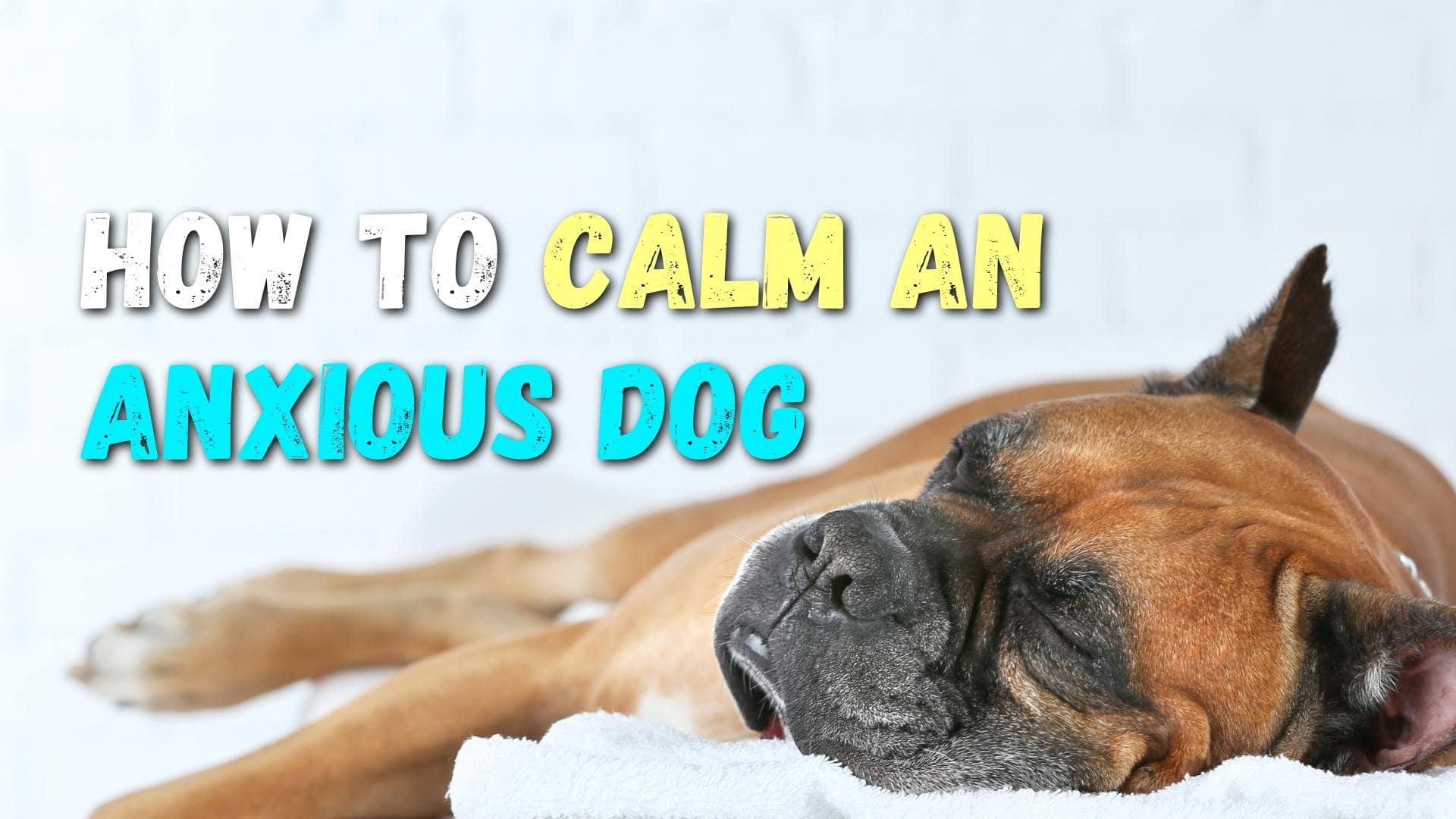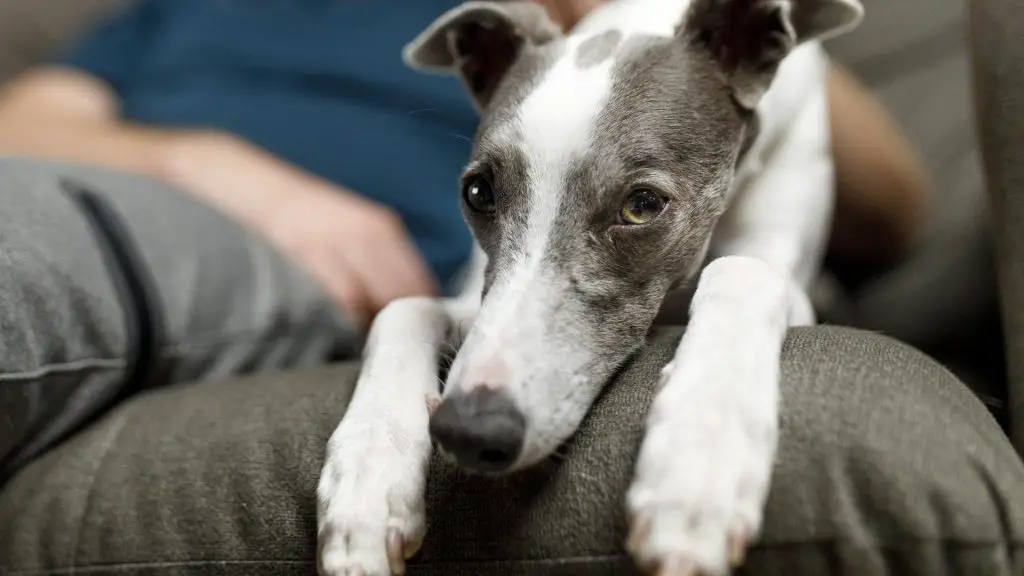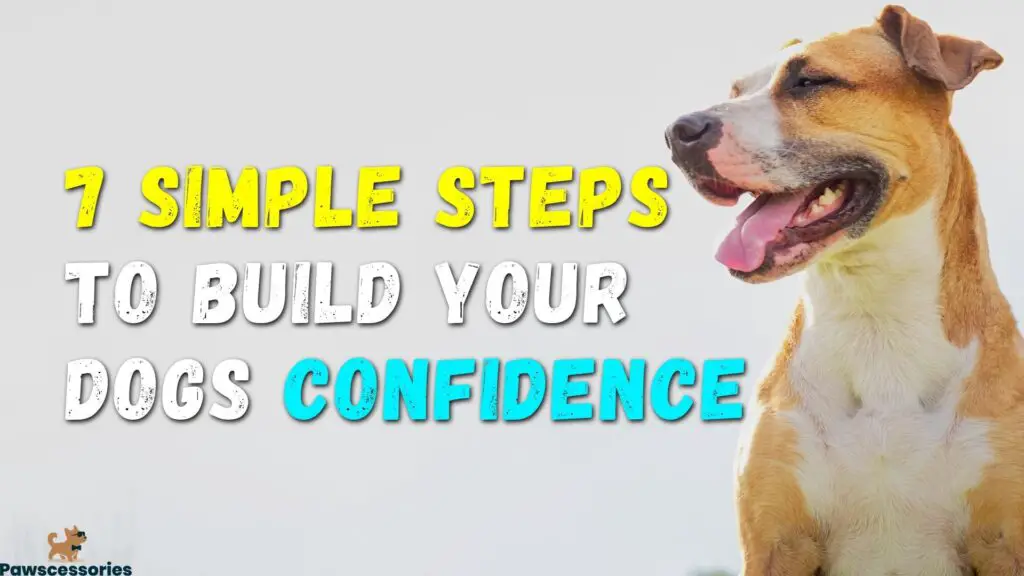Pawscessories is reader-supported. When you buy via links on our site, we may earn an affiliate commission at no cost to you.
Learn more.
If your dog often feels overly anxious in different situations, it can be hard to take them anywhere. Some dogs can be a real handful when they misbehave due to their anxious feelings. So how do you calm an anxious dog?
Well, depending on if your dog has been through a traumatic event, has recently gone through a big environment change, or is just naturally this way, there are simple techniques you can use to help reduce their anxiety and develop their confidence.
The goal being to make them feel safe and secure in any situation, making both your life and relationship with them that much better.
This article can help dogs who:
- Came through rescue or were adopted
- Are anxious, shy or stressed out a lot
- Experienced trauma in their lives at some point
- Shut down easily during training
- Have little to no confidence
In this article I include a full section on 8 tips to help calm anxious dogs. However, these tips are more designed for short term relief. So I also covered 7 additional tips for building your dogs confidence. That way you have short term and long lasting fixes to anxiety.
Let’s dive right in so we can help your pup.
Table of Contents

What Is Anxiety In Dogs?
Anxiety is defined as “a feeling of worry, nervousness, or unease about something with an uncertain outcome”.
PetMD describes it as “the anticipation of unknown or imagined future dangers.” This anxiety results in an automated response from a dogs body. This reactions seem similar to those normally associated with fear.
Separation anxiety is the most common anxiety found in dogs dogs. This usually occurs form a dog that’s left alone for extended periods.
How Do I Know My Dog Has Anxiety?
The first step is identifying when your dog is anxious. You might think it’s obvious when they start to bark or whine incessantly but sometimes the signs can be more subtle.
Here are some of the common symptoms of anxiety in dogs:
- Panting excessively or drooling when they aren’t hot or thirsty
- Pacing back and forth
- Ears pulled back or to the side
- Whale eye (when the whites of their eyes are showing)
- Yawning excessively
- Lip licking
- Shaking or trembling
- Hiding or cowering
- Tucking their tail between their legs
- Nose wrinkling
- Refusing food or treats
- Urinating themselves
If your dog experiences any of these symptoms, they are experiencing anxiety. But don’t worry, there are ways to help them feel better.

8 Effective Ways To Calm An Anxious Dog Naturally
- Exercise.
- Mental & Physical Stimulation.
- Physical Touch.
- Massage.
- Calming Music.
- Create A Safe Space.
- Calming Clothes.
- Natural Therapies.
Exercise
Exercise is the most important activity you can do to calm an anxious dog. It releases endorphins, which have mood-lifting properties, and also tires your dog out so he or she is less likely to be wound up and on edge.
This is particularly important for breeds that were originally bred for high-energy jobs, like herding or hunting. If these dogs don’t get enough exercise, they can become anxious and stressed.
So make sure your dog is getting plenty of opportunities to run, play, and burn off energy every day. A long walk, a vigorous game of fetch, or a session of agility training are all great ways to tire your dog out so he or she can relax at home.
Mental & Physical Stimulation
In addition to exercise, dogs also need mental stimulation to stay calm and content. Boredom and a lack of things to do can lead to anxiety and restless behavior in dogs.
To keep your dog’s mind active and engaged, give him or her plenty of toys to play with, including chew toys, puzzle toys, and interactive toys. You can also teach your dog new tricks or sign him up for a dog sport like agility, flyball, or dock diving.
Doing things that are both mentally and physically stimulating will tire your dog out more than exercise alone, so he or she will be more likely to relax at home.
Physical Touch
Dogs are social creatures that crave physical contact, so cuddling and petting can be very calming for an anxious dog.
When you’re petting your dog, try to focus on the areas that are most relaxing for him or her, like the base of the tail, the shoulders, or the chest. And take care not to pet your dog too vigorously, as this can actually have the opposite effect and make him or her more anxious.
If your dog enjoys being held, you can try wrapping him in a warm blanket or offering them a cuddle. These activities can help to soothe an anxious dog and make him feel safe and secure.
Massage
Just like humans, dogs can benefit from a relaxing massage. Massage can help to reduce stress and anxiety, as well as improve circulation and relieve pain.
To give your dog a massage, start by gently petting him all over with your hands. Then, use your fingers to massage his neck and shoulders in small circles. You can also try using a tennis ball or rolling pin to massage your dog’s back.
Be sure to pay attention to your dog’s body language and stop if he starts to get anxious or seems uncomfortable.
Claming Music
There’s a reason why people say that music soothes the soul. Listening to calming music can help to reduce stress and anxiety in both humans and animals.
There are a number of online playlists specifically designed for dogs that can help to calm them down. These songs are typically slower and have a rhythm that is similar to a heartbeat, which can be very soothing for dogs.
You can also try playing music yourself or singing to your dog. Dogs are very attuned to the tone of our voices, so a calm and soothing voice can help to relax an anxious dog.
Create A Safe Space
Sometimes, the best way to calm an anxious dog is to simply provide him with a safe space where he can feel relaxed and secure. This could be a quiet room in your house where he can go to get away from loud noises or stressful situations.
You can also create a safe space outside by setting up a dog pen in your backyard. This will give your dog a place to go when he wants to be outdoors but doesn’t want to be around people or other animals.
If you have the ability, you can even create a special room or area just for your dog, complete with his favorite toys, bedding, and other comforts.
No matter what kind of safe space you create, be sure to make it a positive experience for your dog by offering treats or rewards when he goes there. This will help him to associate the space with positive feelings.
Calming Clothes

There are a number of products on the market that can help to calm an anxious dog. These include everything from calming collars and wraps to ThunderShirts and weighted blankets.
Calming collars and wraps work by releasing a calming scent that helps to relax dogs. ThunderShirts are designed to apply gentle pressure around your dog’s body, which can have a calming effect. And weighted blankets work in much the same way, by providing a feeling of security and safety.
You can also try using a calming coat or shirt, which are specially designed to help soothe dogs. These products typically feature a soft, fuzzy material that is comfortable for dogs to wear.
Natural Therapies
There are a number of natural therapies that can help to calm an anxious dog. These include things like aromatherapy, homeopathy, and herbal remedies.
Aromatherapy is the use of specific doggy safe essential oils to promote relaxation. Some calming essential oils for dogs include lavender, chamomile, and valerian root. These can be diffused in your dog’s environment or applied topically to his skin (always diluted with a carrier oil).
Homeopathy is a system of medicine that uses very small doses of natural substances to treat illness. There are a number of homeopathic remedies that can be used to calm anxious dogs.
Herbal remedies are another option for calming anxious dogs. Some of the most popular herbs for anxiety relief include valerian root, passionflower, and chamomile. These can be given to dogs in the form of tinctures, capsules, or teas.
Always consult with your veterinarian before giving your dog any natural remedy, as some can interact with other medications.
Now that we’ve cover some tips to help reduce a dogs anxiety in the short term, how can you completely eliminate their anxiety?
It all starts with building their confidence. A confident dog has less anxiety and is better equipped to deal with stressful situations. So rather then you always having to calm down your anxious dog they can coop all on their own.
7 Steps To Build Your Dog’s Confidence & Cure Anxiety For Good

1) Identify Your Dog’s Triggers
The first step in improving your dog’s confidence is to first figure out why they’re anxious, stressed, or shy in the first place.
Dogs have patterns and predictability around the things that push them into a state of fear or anxiety.
When you can identify their trigger(s) you can then take steps to reduce how often they’re exposed to them or help them overcome their negative feelings about their trigger.
Triggers are often dependent on a dog’s life experiences but they can also be genetic in some cases.
So, as best as you can, think back to what seems to always set off your dog’s anxiety and them down. Your list might include:
- Certain sounds (thunder, sirens, etc.)
- People
- Being alone
- Unfamiliar dogs
- Cars
- The vet
- Large groups of people
- Water
You may want to consider enrolling in SpiritDogs Confidence Booster Training — After trying dozens of different programs to help build a dog’s confidence this is by far the best I’ve found.
Steffi (the creator) has over 32,226 students across her trainings with 100% satisfaction.
For just $35, You get lifetime access to professional dog trainers, on demand step by step video training, instructional PDFs, progress tracking, all from the comfort of your home.
So go ahead, try out SpiritDogs Confidence Booster Training at no risk with their 60-day money back guarantee.
2) Subtle Socialization
Most shy and anxious dogs are uncomfortable in situations with other people and animals.
This can often stem from a lack of socialization throughout the dogs’ upbringing.
In order to build your dog’s confidence, developing a dog’s social skills can be one of the best ways to do this.
A dog that is properly socialized loses all fear and stress around social settings.
The key here is making sure that when you are socializing your pup that you make sure the experience is positive.
Any negative event will set your progress back.
So in order to increase the chances of a happy experience you’ll want to make sure to do this in small increments.
For example, if your dog is triggered by other people, you want to bring a friend over that is aware of the plan and only have 1 friend over.
That way your dog is not overwhelmed and your friend understands it’s a training exercise.
On the flip side, when socializing dogs you want to only invite 1 other dog over and you want to make sure that dog is well trained.
You do not want to bring another dog over to socialize when they are ill mannered and might have a history of negative social experiences.
If you don’t have a friend with a dog you may want to consider some training classes or reach out to some local pet groups to find someone willing to help.
3) Train Your Dog!
Believe it or not, a shy, fearful dog that understands your commands and what they need to do is less likely to panic.
This will build your dog’s confidence over time.
Stick to simple commands like, “come”, “sit”, and “stay”. Never use overbearing training styles, or loud / intimidating voices.
Also make sure to stay calm and supportive, you don’t want to be over-the-top with your praise either.
Try adding in fun games like fetch or hide-and-seek. Worried dogs often have a hard time enjoying things so simple games can bring them out of their worry cycle.
Another thing to mention is to make sure you are training in a quiet room with no distractions. After a while of success you can then start to introduce more distractions.
Lastly, If you know your pup gets triggered by loud noises or certain objects, begin the process of desensitization.
If you’re someone who has been struggling to build your dog’s confidence, you may want to consider one of these in depth online dog training programs .
5) Desensitize Your Dogs Triggers
Desensitization is the process by which you gradually introduce your dog to the trigger causing their anxiety and stress.
This needs to be done slowly over time and in small incidents depending on the severity of your dog’s response to the trigger.
For example, if the sound of a car triggers your dog’s anxiety, you can start to quietly play the noise, and anytime the sound is made, give your dog a reward.
Make sure the reward is highly valued by your dog. You want your dog to feel amazing anytime the trigger occurs.
The better the reward the better they will feel and the easier it will be for them to become desensitized to the trigger.
4) Know What Things To Avoid
When your dog is scared, or anxious about certain things you’ll want to avoid putting them in situations that make things worse.
The more often their anxiety and fear is triggered the more it reinforces the behavior.
Here are a list of things you should avoid:
- Tethering your dog in public while you leave.
- Forcing your dog into fearful situations for them, thinking “this is how they overcome their fear”.
- Don’t encourage other people to reach out or pet your dog. Let your dog go to them.
- Avoid overbearing dog training styles. This will cause them to shut down.
- Forcing your shy dog out from hiding. If they are hiding under the table from the thunder, forcing them out only makes things worse.
- Taking your dog into chaotic, busy environments such as dog parks, firework displays, malls, skateboard parks etc.
These are just a few things you should stay away from, however, all dogs have different triggers and levels of worry.
You know your dog best so if you think a situation may cause your dog to become anxious, avoid it.
6) Protect Them From Their Triggers
No dog can build confidence if they are constantly scared.
If you follow step 1 you will know exactly what your dog’s triggers are, it’s your job now to protect them from those triggers – for now.
While trying to develop your dog’s confidence you want to reduce their exposure to the triggers that are bothering them.
That way you can slowly desensitize them without any events happening that may set your back.
Some methods for keeping the scary things away include:
- Door signs to prevent people from knocking or ringing the doorbell.
- Get a white noise generator to drown out small noises that could potentially startle your dog.
- Change your walking schedule
- Window film covers to block your dog’s views
7) Get Expert Help
Depending on the severity of your dog’s response to certain triggers, one of the fastest ways to get this problem solved is to go to the experts.
Although it can be quite expensive to have trainers take your dog it can be one of the best choices for some.
Another option is to get specialized training online. Now, I’ll be the first to admit a lot of online programs are not very good. We’ve reviewed a ton of really bad dog training programs.
However, we’ve recently compiled a list of affordable online dog training programs that will give you the step by step guidance to transform your dog. I personally went through these courses and cannot recommend them enough.
These are the best online dog training programs out there today.
Final Thoughts
Anxious dogs are not fun for anyone. Not only is it stressful to see your dog in that state but it can be dangerous if their anxiety gets too out of control.
Fortunately, there are a number of things you can do to help ease your dog’s anxiety and help them become more confident.
The most important thing is that you remain patient and consistent with your approach. Changing things up too much will only make things worse for your dog.
